Mr. Ashok Patel is the Founder and CEO of Max Ventilator. Mr Patel has been a prominent face in the health technology sector for over four decades now. Mr Patel initially established A B industries focused on power management and control systems and equipment at Vadodra, Gujarat. However in 1992, in view of the surging demand from the medical fraternity and the domination of the existing ventilator market by foreign players supplying the critical care equipment at exorbitant rates, the company diversified into making medical ventilators. Under Mr Patel’s able leadership, over these nearly three decades, the company has come a long way registering impressive growth and carving a name for itself as a specialist ventilator maker in the domestic as well as foreign market.
The COVID-19 pandemic didn’t only affect the people infected by the virus but also the healthcare industry in general and the medical devices segment in particular. This single cause has managed to irrevocably change the industry’s future, bringing about a deep focus on wellness and customisation of services as per the patient, and thus on wearable devices and 360-degree collaboration opportunities brought on by the Internet of Things (IoT) in the medical product development process. Hence, industry stakeholders are looking at means to adapt to increasingly virtual, innovative health management systems and devices that’ll be able to support these systems and patients even at their homes.
Factors leading to the dawn of the digital era in MedTech industry
The medical technology (MedTech) segment has been subject to a gamut of factors that’s forcing it to change, and this process begins with managing a demand for rigorous regulations and burgeoning cost pressures to operational roadblocks stemming from an all-encompassing need for merging stakeholders’ efficiencies. Industry players are being led to quicken the pace of the digitalisation of their entire systems in order to match the new consumer needs and for business expansion purposes.
Even in pre-COVID times, Business 4.0 technologies such as wearable devices, the IoT, etc., were gradually transitioning into the mainstream healthcare sphere. Since the advent of the virus, MedTech has been thrust into the spotlight of transformation without a preamble. In the pandemic, news revolved around the necessity of critical products such as testing equipment, protective gears, wearable devices, ventilators or the scarcity there of. With business as usual disrupted completely, the sector has to turn to disruptive models over traditional ones to find their feet in this new normal. While this cascading effect has been noted across the value chain, be it in sales and marketing, manufacturing, R&D, or supply chain, the medical device fraternity has felt the effects particularly strongly.
IoT and connectedness in manufacturing and distribution
In the immediate aftermath of COVID-19, MedTech worked at various means of maintaining hygiene and safety through safety suits and tests, and boosting home-patient care and post-infection care facilities by providing various wearable gadgets, collapsible beds, portable ventilators, etc. In 2021, stakeholders took cognisance of the dynamic situation and its long-reaching impact to formulate and rework policies and regulations to prepare for the future and optimise inventories and costs in order to have a better grip on the global scenario. So, supply chains became diversified and product portfolios were rationalised to combat risk, while adoption of digital tools to ease remote collaboration, strategic sourcing, and redistributed manufacturing with a view to manufacture products geographically closer to the markets were happening at the back-end. Change with a purpose was all that differentiated the good from the mediocre players.
Telemedicine and remote monitoring: The new frontier
If there’s one frontier that the pandemic has completely changed, it’s the narrative of seeking medical consultation by moving it majorly online. Hence, the frequent use of wearable devices, telehealth, electronic medical records powered by blockchain technology, and innovative manufacturing techniques by leveraging technology such as 3D printing that sounded light years away is now a reality. With so much data being collected, Big Data will have to necessarily be employed to segregate and mine important analysis that will drive further changes in MedTech, while keeping wellness at the centre of healthcare.
Softening the digital transformation for consumers
With the new-age health system constantly changing and getting upgraded very frequently, patients are bound to be concerned about how to adapt to them. While
The system being constructed will have wellness and the consumer at it hearts, and more importantly will be completely digitally connected, the medical devices sector will also have to play a key role. From being an overlooked segment to becoming the lifeblood of healthcare, the devices sector has been thrust to the forefront of the changing industry as its ambassador.
And hence, given the vast transformation healthcare is undergoing, it will be up to the device manufacturers to reinvent themselves into the role of allied health solutions providers. In this role, as they already understand the nature and necessity of digital transformations, they will be responsible for explaining the significance of these innovations to the consumers in a reassuring manner. These players will have to make each disruption accessible, affordable upgrades to how things were traditionally and also help build awareness and trust around them.
The way ahead
How the medical device players respond to the present challenge is what’ll decide their future—for they’ve to embrace purpose and Business 4.0 technology. But those device companies that’ll be able to do so well will create immense value for themselves and emerge as the newly minted adaptable industry leaders that are in sync with the changed world.


